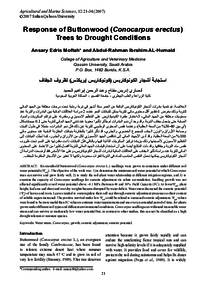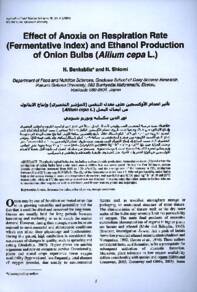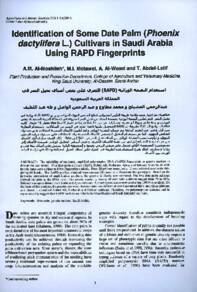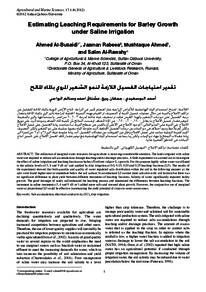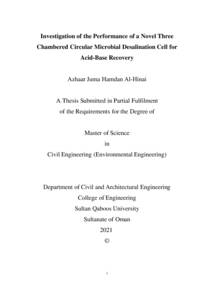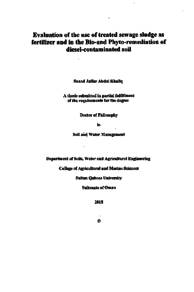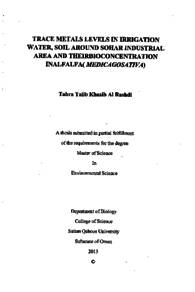Document
Response of Buttonwood (Conocarpus erectus) Trees to Drought Conditions.
Contributors
AL-Humaid, Abdul-Rahman Ibrahim., Author
Publisher
جامعة السلطان قابوس. كلية العلوم الزراعية والبحرية
Gregorian
2007
Language
English
English abstract
Six-month-old buttonwood (Conocarpus erectus L.) seedlings were grown in containers under different soil water potentials (Ψsoil). The objective of the work was: 1) to determine the minimum soil water potential at which Conocarpus trees can survive and grow fairly well, 2) to study the soil-plant water relationship at different irrigation regimes, and 3) to examine the capacity of Conocarpus seedlings for osmotic adjustment via solute accumulation. Seedling growth was not affected significantly at soil water potential above –0.1 MPa (between 40 and 30% Field Capacity (FC). At lowerΨsoil, plant height, leaf area and shoot and root dry weights became disrupted by water deficit. Water stress decreased the osmotic potential (Ψπ) of leaves and roots. Leaves tended to osmoregulate their cell sap through osmotic adjustment processes as their content of soluble sugars increased. The positive survival under low Ψsoil could be related to increased osmotic adjustment. Ψsoil values were found to be more useful than FC values to estimate water requirements and use over an extended period of time, for plants grown under different soil types and different environmental conditions. Conocarpus seedlings can withstand reasonable water stress and can survive at moderately low water potential but, in contrast to other studies, this can not be classified as a high drought tolerant or resistant species.
Member of
ISSN
2410-1079
Resource URL
Citation
Moftah, A. E., & AL-Humaid, A. I. (2007). Response of Buttonwood (Conocarpus erectus) Trees to Drought Conditions. Agricultural and Marian Sciences Journal, 12 (1), 21-34.
Arabic abstract
تم تنمیة بادرات أشجار الكونوكاربس البالغة من العمر ستة أشھر في تربة رملیة تحت درجات مختلفة من الجھد المائي للتربة وذلك بغرض 1-تقدیر أقل محتوى مائي للتربة یمكن للنباتات النمو عنده، 2-دراسة العلاقات المائیة بین البادرات والتربة عند مستویات مختلفة من الجھد المائي، 3-اختبار مقدرة الكونوكاربس على التنظیم الاسموزي ومقدرتھ على تراكم السكریات والمواد الصلبة حتى یتحمل جفاف التربة. وقد وجد أن نمو البادرات لم یتأثر تأثیرا معنویا عند تدني الجھد المائي للتربة حتى 0.1 میجاباسكال (أي بين 40-30% من السعة الحقلیة)، وعندما نقص المحتوى الرطوبي للتربة عن ذلك فأن نمو البادرات، متمثلا في طول النبات ومساحة الأوراق والوزن الجاف للمجموع الخضري والجذري، قد تأثر كثیرا بالمقارنة بنباتات المقارنة النامیة عند محتوى مائي 100% من السعة الحقلیة. وقد أدى الجھاد المائي إلى تناقص الجھد الأسموزي لكل من الأوراق والجذور، كما لجأت النباتات إلى التنظیم الأسموزي لأنسجتھا وذلك بزیادة تركیز السكریات الذائبة فیھا وبالتالي فأن النباتات ذادت مقدرتھا على النمو تحت ظروف نقص ماء التربة وجفافھا. وقد دلت النتائج أیضا على أن استخدام قیاسات الجھد المائي للتربة أفضل كثیرا من الاعتماد على المحتوى المائي للتربة عند دراسة تأثیر الجفاف على العلاقات المائیة لبادرات أشجار الكونوكاربس، وعلى ھذا الأساس فقد أوضحت الدراسة أن أشجار الكونوكاربس یمكنھا تحمل النقص المناسب للماء في التربة لفترات محدودة ولكنھا لا تعتبر من الأشجار المقاومة للجفاف.
Category
Journal articles

